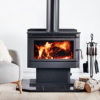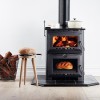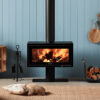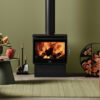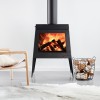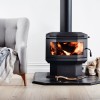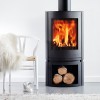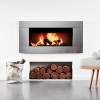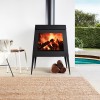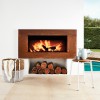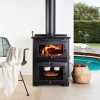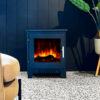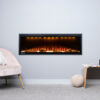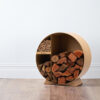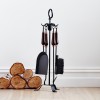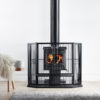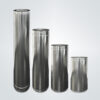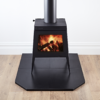Can I purchase my heater / accessories / spare parts from Scandia?
As the manufacturer, we operate solely through the Bunnings Network, and our products are available for purchase at your local Bunnings Store.
Can Scandia send someone to install / service our new appliance?
Scandia cannot install appliances. Scandia is the manufacturer and supplier of the appliances. Installation should only be completed by a suitably qualified trades person:
Only engage suitably qualified and experienced tradespersons to complete any solid fuel (wood) or gas appliance installation – regulations vary so check with your local and state authorities. Examples of qualified trades would be roof plumbers/gas plumbers/qualified appliance installers.
Suitably qualified trades will ensure the safe and compliant installation of the appliance ensuring that the appliance is installed as per the manufacturers specifications and in accordance with AS/NZS 2918:2018 Domestic Solid Fuel Burning Appliances – installations for solid fuel appliances (wood) and AS/NZS 5601.1:2013 Gas Installations – General Installations for gas appliances.
Can I install my wood heater myself?
Unfortunately, no. Wood-fire heaters and fireplaces require a qualified professional to install them whose work conforms with local council regulations, Australian Standards & manufacturers recommendations. It is a requirement that all Scandia solid fuel and gas appliances are fitted by a qualified, licensed installer whose work complies with local council regulations, Australian standards, and manufacturer’s specifications. Failure to correctly install is extremely dangerous, will void any warranty claims and may compromise any future insurance claims.
I need to make a warranty claim for my heater, how do I do this?
Our aftersales team can help with appliance troubleshooting and issue support, just send an email to [email protected] and be sure to include the following details to assist us in resolving your issue promptly.
- Proof of Purchase
- Serial number
- Details of the issue
What are the advantages of wood-fire heating?
Other than the obvious soothing warmth that a wood fire provides, heating with wood is both sustainable and economical. And with the current Australian Standard being one of the strictest in the world, the impact of a wood-fire on the environment is significantly lower than that of other heat sources.
What kinds of running costs do I need to consider?
The Australian Home Heating Association (AHHA) recommends that your appliance’s firebox and flue be inspected every 12 months. You can do this yourself, or you can call your local chimney sweep. The cost for replacements or repairs is based on the use of your unit. So, if your unit is under pressure for long periods you may have to replace items more often.
Can I use my existing flue system for my new wood-fire heater?
Unfortunately, no. It is recommended that all Scandia appliances be installed using the recommended Scandia flue kit and extensions.
How important is KW output?
Heat is rated in kilowatts (kW). So, each wood-fire heater is graded on the amount of kWs it can produce. The amount of KWs you might require depends on how large and well-insulated your room is. A convection wood-fire heater does not rely on a large kW output. The aim is to utilise the circulated warm air again and again and not let it escape through the flue. Conversely, a radiant wood-fire heater creates less energy (using less wood) but effectively transfers those kWs from the heater to your home.
Where are Scandia wood-fire heaters made?
Scandia is an Australian owned company, and our appliances are designed and developed in Australia and manufactured in our purpose-built factories in China using CNC laser technology and robotics to manufacture our products to an impeccable quality.
How do I choose the wood-fire heater that is best for me?
First, let’s identify your needs: Is this going to be your primary source of heat? Or are you looking to change the aesthetics of your home? If it’s a primary heat source, you’ll need to consider layout, ceiling height, insulation type and windows. Output of heat is measured in building squares: 1 square being approx. 10m2 . So, accurate measurements of your home will help you to determine the right heater for you. If your wood-fire heater is for ambiance, then a small to medium size option would suit your needs. Please see brochure below for more detailed information.
Are Scandia Appliances Certified?
All Scandia appliances are tested and accredited by a NATA accredited laboratory to conform for certification to adhere to:
AS/NZS 4012:2014 Domestic solid fuel burning appliances – Method for determination of power output and efficiency
AS/NZS 4013:3014 Domestic solid fuel burning appliances – Method for determination of gas flue emissions
AS/NZS 2918:2018 Domestic solid fuel burning appliances – Installation
Certified appliances are listed on the below websites
Australia – Australian Home Heating Association (AHHA) – http://www.homeheat.com.au/wood-heaters/certified-wood-heaters
New Zealand – Ministry for the Environment – https://www.mfe.govt.nz/woodburners
Can you give me a price on an appliance?
No, as Scandia are exclusive to Bunnings, Scandia does not have retail pricing as we do not sell direct to the public. You will need to make a pricing enquiry in store or online at Bunnings.com.au
Why do my baffle and fire bricks need replacing?
There are consumable parts on appliances that will over the appliances lifetime require replacement. The frequency of replacing these is dependent on usage and maintenance.
Can I use another flue kit with my Scandia appliance?
Scandia appliances have only been tested with Scandia Flue kits, as such we are unable to advise on alternate flue kit compatibility.
Can you advise me on what parts will be needed to install my appliance?
All installations have varying requirements that will require different component accordingly (refer to Installation tab). It is recommended that consultation is sought along with the engagement of a suitability qualified trade to complete any installation to ensure that the appliance and flue is installed to the manufacturer’s specifications and in accordance with AS/NZS 2918-2018 Domestic Solid Fuel Brining Appliances – Installations.
What is a baffle for?
The baffle is important as it creates a barrier between the intense heat created from your fire, and the top of your wood stove. A baffle also helps create a path for smoke and gases in the firebox for as long as possible. Nonetheless, some people can make a wood-burning stove baffle last for several years, while others find they have burned through or warped the baffle within a year, it is highly dependent on the way the appliance is used.
Can you tell me what gas flue kit I need?
Unlike solid fuel (wood) appliances, gas appliances do not have a flue kit, rather a flue system that is made up of flue components. It is imperative that consultation and engagement of a qualified gas installer is sought for the correct componentry required for any gas appliance installation. There are specific installation configurations that must be adhered to with the installation of the Avedur appliance. It is vitally important that these are adhered to ensure that the appliance functions as it is intended. The appliance must be installed to the manufacturer’s specifications and in accordance with AS/NZS 5601.1:1013 Gas Installations. Failure to adhere to this may void the consumers warranty and adversely affect the consumers home insurance.
Can I use Scandia firebricks in a pizza oven?
Scandia has not tested firebricks for the use in wood fired pizza ovens. Scandia cannot confirm if utilising firebricks in a pizza oven is food safe. In theory the bricks will work.
How far above my TV must my above my appliance be (wood/gas)?
Must follow instruction for clearance to combustibles specific to the appliance (refer operating manual) and in accordance with AS/NZS 2918:2018
What is the minimum clearance required to a non-combustible surface?
Scandia recommend a minimum of 100mm clearance for air flow when determined non-combustible. Scandia cannot advise on what is classified as a certified non-combustible, and this advice is general in nature. Consultation and engagement of a suitably qualified installer should be sought to ensure that the appliance is installed to the manufacturer’s specifications and in accordance with AS/NZS 2918:2018 – Domestic Solid Fuel Burning Appliances – Installations.
Can Scandia give me a copy of AS/NZS 2918 or AS/NZS 5601, or where can I obtain a copy?
AS/NZS 2918:2018 and AS/NZS 5601.1:2013 are protected under intellectual property laws. The standards and the conditions of the standard are dictated by government authorities. Scandia cannot provide a copy of any standard as this is a breach of law. When you engage a suitably qualified trade, this trade should be well versed with the standard, if they are not, we would question their qualifications and suitability to complete a compliant installation. Should a consumer request where they can obtain copied of standards, please refer to the notes besides, please note that there are fees associated with obtaining standards.
What is the difference between a combustible and non-combustible surface?
Combustible Surface anything that can burn (i.e., plaster, wallpaper, woods, fabrics etc.). It is important to note that this is not limited to those visible and include materials that are behind non-combustible materials. Consultation and the engagement of a suitably qualified installer should be sought to ensure that the appliance is installed safe and compliant to the manufacturer’s specifications and in accordance with AS/NZS 2918:2018 Domestic Solid Fuel Burning Appliances – Installation.
Non-Combustible Surface anything that cannot burn (i.e., concreate, stone, brick etc.) Consultation and the engagement of a suitably qualified installer should be sought to ensure that the appliance is installed safe and compliant to the manufacturer’s specifications and in accordance with AS/NZS 2918:2018 Domestic Solid Fuel Burning Appliances – Installation.
How can I reduce clearances for an appliance?
To override tested clearances for an appliance, the installer should refer to the Australian Standard AS/NZS 2918:2018 Section 3: Appliance Installation. Section 3 of the standard elaborates on additional heat shielding and reducing clearances using ‘heat tolerant’ material. The definition for ‘heat tolerant’ material can also be found within the definition section of the definition section of the standard.
The glass on my appliance is back, what can I do?
All Scandia combustion appliances are manufactured with ‘Clearview’ glass air wash as standard feature which is designed to minimise the amount of time spent cleaning glass. When a build-up of soot is detected, the first course of action is to increase the intensity of the fire by opening the air slide to maximum for a short period of time, this should burn off any residual particles. Should this fail to rectify the situation there are several options available:
1) The traditional method involves dipping a damp piece of newspaper into the ash bed and wiping the glass in a circular motion, repeating until the soot is removed, then wipe over with a clean damp cloth. This should only be done when the fire is completely cool.
2) Alternatively, there are many glass cleaning products on market that are specifically designed for the purpose each with varying degree of effectiveness. It our product is Scandia glass and surface cleaner (item number SCAGSC).
To minimise soot, build up on appliance glass, only burn good quality, well-seasoned hardwood. Poor quality wood with a high moisture content is the largest contributing factor when it comes to the build-up of soot and creosote.
Why do Australian appliances burn only hardwood and New Zealand appliance burn only soft wood?
Scandia appliances are specifically manufactured to burn species that are the most sustainable and prolific.
My Appliance has surface rust what can I do?
Lightly sand the affected area, wipe clean with a clean damp cloth, and apply Senotherm High Temperature (item number SCPC400MB) paint to the appliance by following the instructions.
How do I stop smoke from coming into my house form the fire?
All solid fuel (wood) appliances will release some smoke when the door is opened, it is suggested opening the appliance door slightly for a few seconds prior to fully opening, this will eliminate downdraught from the pressure change. Opening the door slightly will promote an increased draught in the flue which will draw most of the gas and smoke out of the firebox and up the flue.
Appliances with bay windows (i.e., Supremacy) are renowned for releasing small amounts of smoke into a room, this is due to smoke that accumulates in the protruding section of the bay window and will require greater draught to extract from the firebox. Following the procedure will minimise instances of occurrence, however the nature of the appliance means that this will never be eliminated. (Please refer to appliance troubles hooting for further information on this topic).
How can I clean the external of my appliance?
Never use solvents or abrasives. Wipe down with a clean damp cloth.
How to maintain my wood heater.
After the initial installation of an appliance and flue, it is recommended checking the flue system once a month. It should be noted of any noticed pattern of soot and creosote build-up, from this it can be determined the intervals for inspection for ongoing maintenance specific to the appliance. The below should be included in regular inspections carried out at least twice a year. If there is an issue, it should be corrected immediately, if a component requires replacement, this should be done immediately. Never use an appliance that is damaged or has a damaged flue.
1) Check the flue system for soot or creosote build-up and for any evidence of damage to joins.
2) To check the flue outlet, remove top baffle by lifting and pulling out at end. Use a flashlight to check flue outlet. Clean and repair as necessary. Always replace top baffle before relighting the appliance.
3) Check the appliance glass. Ensure no presence of cracks or chips in glass and that the rope seal is in good condition. Replace as required.
4) When room is dark, use a strong flashlight to check the sealing of the appliance at the edge and corners for leaks. Any leaks or cracks found should be repaired with fibre cement or damaged components be replaced with genuine spares.
5) During periods of inactivity or infrequent use, regular alternate the position of the flue damper and any other movable controls. It is recommended to place a silica bag in the fire box to absorb any moisture to avoid rust.
6) Check the appliance door is tight and well-sealed when closed. Place a strip of paper between the appliance door and body and close the door; try to pull the paper from position. There should be some resistance to the pull, check several points around the door. If the paper pulls out easily, replace the rope and seal in place with a suitable high temperature sealant.
7) Inspect appliance baffle plate and firebricks. Baffle plate should be replaced if a hole or deterioration appears in the surface of the plate. Firebricks should be replaced when there is evidence of bricks crumbling or where the firebox is exposed.
Door Adjustments
Appliance door adjustments will be required at times throughout the life of the appliance. After completing the paper test, door adjustments should be made in accordance with the appliance operation manual or follow the short video below.
My fire is burning too quickly
Can be caused by too much draught or air:
- Try reducing the air supply to the appliance by closing the air controls, if this fails then you may have to adjust the door or there may be damage to the door seal.
- Close a thin strip of paper in the door of the appliance, check to see if the paper stays in place or falls away. If the paper falls or is easily pulled from position, the appliance door may need adjustment.
- Inspect the glass for any movement within the door frame. If there is movement then the glass retainer screws may need tightening.
- Inspect the condition of the door sealing rope and glass tape for deterioration and replace where required.
- Low quality fuel (firewood): refer to what wood to use.
What are council requirements for installation?
When installing, operating, and maintaining your wood heater, follow the guidelines presented in these instructions, and make them available to anyone using or servicing the wood heater. Your city, town, state, or territory may require a building permit to install a solid fuel burning appliance. Always consult your local building inspector or local council to determine what regulations apply I your area.
What do I need to do on the first use of my appliance?
You should begin using your wood heater by lighting small fires which get progressively larger. We recommend lighting approximately 5 small fires before you put the wood heater in full use. Allow the wood heater to fully cool between each of these fires. There may be some smell and a small amount of smoke from the wood heater during the initial operations. This is perfectly normal and is merely the curing of the wood heater paint. Opening a window or door to provide additional ventilation will help alleviate this.
Can I burn my wood heater overnight?
You wood heater is designed to maximise burn times. Best results are achieved when you establish a good fuel bed and allow it to burn for about 30 minutes before closing the air slide control fully.
When you return, fully open the air slide control until you have a good fire and then set to normal operating levels. Do not add fuel until the fire bed is hot and red. Then add a little for the first time and allow that to ignite before adding more. During overnight burning, the wood heater glass may blacken, but when a hot fire is established again this should burn off.
How long is the warranty period on my heater for?
The firebox carries a 10-year warranty; however, all consumables have a warranty of 12 months.
Where can I purchase Scandia spare parts?
All Scandia products can be purchased exclusively from Bunnings.
My heater is not heating up the room
1: Fuel too moist (firewood): (not seasoned enough) firewood need to have a moisture content of <20%, ideally under 15%. Australian hardwood will take approximately 18 months to dry, firewood with a moisture content above 25%, combined with wood pieces that are too large will lower the temperatures in the firebox dramatically.
2: Firewood too large: larger pieces need more primary air (air through the bottom grate) too much primary results in heat loss through the flue. Natural convection works best with primary air shut down. Refer to air control specific to the appliance (in appliance manual)
3: Air Gaps under doors: Ensure that the appliance door is adjusted so that it is airtight. Ensure heater does not draw cold air from gaps under outside doors.
4: Ceiling Vents: Warm air must not be allowed to escape into open ceiling vents.
5: Incorrect Burning: once the fire is established (approximately 40 minutes after initiation) primary air should be shut down; now secondary air (from the top of the firebox) will establish a slow burn with lots of coal and embers (approximately 700 degrees inside firebox)
6: Incorrect flue draw: make sure the flue draw is not obstructed. This may happen through the build-up of ash at the flue entry inside the firebox, (above the vermiculite/baffle). Small birds or other animals like to make homes in flues, this can also affect draw, along with creosote build-up, flue cleaning should be maintained as parts of regular maintenance. If the flue is not long enough, this will also affect the draw of the appliance, ideally approximately 1000mm from the roof pitch. Topographical and environmental conditions also dictate the correct flue height to ensure an adequate draw for operation
Why doesn’t my heater burn overnight?
Woodfire heaters manufactured now do not have the overnight burn as heaters did previously as per new regulations.
The Australian standard AS/NZS 4012:2013 requires particulate emissions (pm2.5) to be produced by solid fuel burning (wood fire) appliances to be less than 2.5kg.
In 2019 this measure was further reduced to reflect a maximum of 1.5g per kg.
To reduce emissions a fire must burn hotter, this means adding more oxygen to the fire.
The factory-adjusted gap in the primary air slide is pre-defined to ensure that every Scandia appliance conforms to the Australian Standard for Missions and Efficiency.
Can I convert my gas heater from Natural Gas (NA) to Propane (LPG)?
Yes, the gas heater can be converted from Natural Gas (NA) to Propane (LPG) using a conversion kit available through Bunnings stores.
These are a ‘how to’ content of ‘In-a-Minute’ videos for the heater. ‘Installing Firebricks’; ‘Replacing Rope & Glass Seals; ‘Installing Heat & Cook Hot Water Jacket’, etc…
Do you have a showroom?
We have a showroom at 58 Access Way, Carrum Downs, Victoria, 3201 where you can come and view our products during business hours Monday to Friday.
What are the units made from?
Painted steel.
When do I need a zero-clearance box?
When you are installing in tight spaces to prevent combustibles close by burning.
Where can I buy spare parts from?
Bunnings.
Are the fascia's included with the units?
Yes.
If we order from Bunnings, can we pick up order directly from Scandia?
No.
